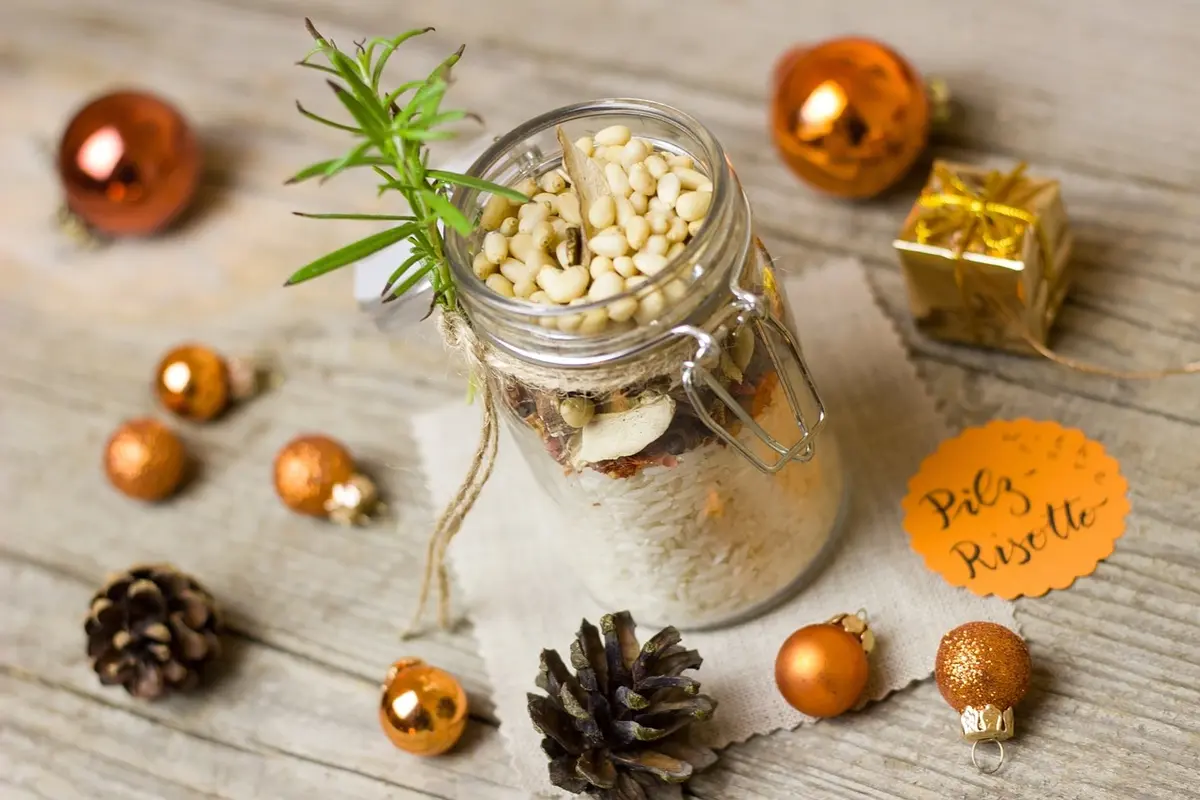Introduction
Embarking on our journey into the enigmatic world of Pignole, we delve into a subject that, while not universally recognized, holds unique charm and complexity. This exploration goes beyond just uncovering the literal definition. It’s about grasping the broader implications and the rich history, uses, and cultural significance that Pignole embodies. Through this article, we aim to unravel Pignole’s mysteries. By the end, we hope to familiarize readers not just with its essence but also with the nuances that make it a topic worthy of deep exploration. This narrative promises to enlighten us, enhancing our understanding and appreciation of Pignole’s diverse nature.
Unveiling Pignole: A Comprehensive Overview
At the heart of our exploration is the quest to define Pignole. In its simplest form, it can be seen as a term that might refer to a specific type of nut, a culinary ingredient, or perhaps even a concept or product specific to certain cultures or regions. The ambiguity surrounding Pignole adds to its intrigue, inviting us to dig deeper into its origins, characteristics, and applications.
The Origins and Etymology of Pignole
Tracing the roots of Pignole leads us into a historical voyage, where we uncover its first mentions and the linguistic journey it has embarked on over the centuries. This exploration is not merely academic; it provides insights into the cultural and geographical contexts that have shaped the understanding and use of Pignole.
Characteristics and Types
Moving beyond the basics, we delve into the characteristics that define Pignole. This section aims to dissect the physical and perhaps even the chemical properties that make it distinct. Furthermore, if it refers to a type of nut or ingredient, understanding its varieties and types becomes crucial. Each variant may carry its own unique flavor profile, nutritional benefits, and culinary applications, enriching our comprehension of Pignole‘s versatility.
Culinary Uses and Health Benefits
The use of Pignole in cooking and its potential health benefits constitute a vital part of our exploration. Whether it’s a key ingredient in traditional dishes or a modern culinary delight, it has a role to play in the gastronomical world. This section not only highlights its culinary applications but also touches upon the nutritional aspects, offering a glimpse into how it contributes to a balanced diet.
Cultural Significance and Applications
Beyond the kitchen, Pignole holds a place of importance in various cultural traditions and practices. This part of the journey explores the symbolic value and applications of Pignole in different societies. Whether it’s part of festive celebrations, traditional rituals, or used in non-culinary ways, understanding the cultural significance of Pignole adds depth to our overall comprehension of this fascinating subject.
Through this comprehensive overview, we embark on a detailed exploration of Pignole, aiming to illuminate every facet of its existence. As we move forward, let us keep an open mind, ready to absorb the wealth of information that awaits us in our quest to fully understand Pignole.
Pignole in Global Cuisines

A Staple in Mediterranean Cooking
In the heart of Mediterranean cuisine, Pignole shines as a key ingredient, infusing dishes with its nutty essence. From the pine nut-studded expanses of Italian pesto to the savory fillings of Middle Eastern meatballs, these tiny kernels play a pivotal role in creating rich, nuanced flavors. Their versatility is showcased in a variety of recipes, illustrating the Mediterranean’s deep-rooted love affair with it.
Pignole’s Role in Asian Culinary Traditions
Venturing eastward, Pignole’s influence extends into Asian cuisines, where it adds a delicate crunch and flavor to both sweet and savory dishes. In Korean cooking, pine nuts are often used in porridges and desserts, embodying a symbol of health and longevity. Similarly, in Chinese cuisine, they’re tossed into stir-fries and rice dishes, offering a subtle contrast in texture and taste.
Fusion and Innovation: Pignole’s Modern Journey
The modern culinary landscape sees Pignole as a bridge between traditional and contemporary cooking. Chefs around the world are getting creative, incorporating these nuts into fusion dishes that marry distinct culinary traditions. From pine nut crusted proteins to innovative desserts, Pignole continues to inspire and redefine gastronomy.
Culinary Uses and Recipes
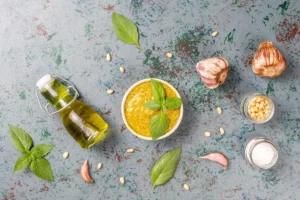
Unlocking the Flavor: Tips for Using Pignole
To fully harness the flavor of Pignole, a few culinary tips can make all the difference. Toasting pine nuts before adding them to dishes can enhance their nutty aroma, elevating the overall taste profile. However, due to their high oil content, they burn quickly, so keeping an eye on them is crucial. Whether blending into pesto or sprinkling over salads, the key is to balance their rich flavor with other ingredients.
Classic and Contemporary Pignole Recipes
Let’s dive into the culinary delights that Pignole can bring to your table. Starting with the classic Genovese pesto, where Pignole acts as the backbone, lending creaminess and depth to the basil-based sauce. Moving on, we explore innovative recipes like pine nut hummus, offering a twist on the traditional with its richer texture and complex flavor profile. For those with a sweet tooth, pine nut brittle provides a perfect blend of sweetness and crunch, showcasing Pignole’s versatility.
Health Benefits and Nutritional Insights
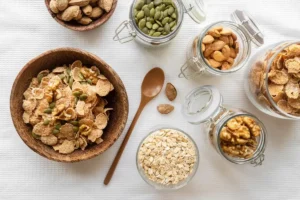
A Nutrient-Dense Powerhouse
Pignole is not just a culinary delight but also a nutritional powerhouse. Packed with antioxidants, vitamins E and K, magnesium, and zinc, these nuts support a myriad of health benefits. Their rich content of monounsaturated fats contributes to heart health, while their fiber aids in digestion.
Incorporating Pignole into a Healthy Diet
Incorporating Pignole into your diet can be as simple as sprinkling them over your morning oatmeal or blending them into smoothies. For those looking to enhance their meals’ nutritional value, adding a handful of toasted Pignole can introduce a new layer of flavor while boosting your intake of essential nutrients.
Cultivation and Harvesting of Pignole
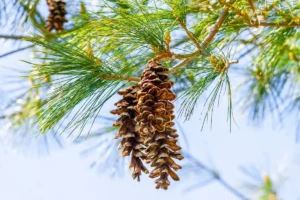
The Art of Growing Pine Nuts
Growing pine nuts, or Pignole, embodies a unique agricultural practice, reflecting patience and care. The trees that yield these nuts, mainly from the Pinus genus, require specific climatic conditions and thrive in the temperate zones of the Northern Hemisphere. Cultivating them demands a long-term commitment, as these trees need years to mature and produce the cones that give us the nuts.
Harvesting: A Delicate Balance
Harvesting Pignole involves tradition and precision. Workers often collect the pine cones by hand and then extract the nuts in a way that preserves their delicate flavor and texture. This activity usually takes place in the autumn when the cones are ripe. Afterward, drying the nuts is a crucial step that enhances their taste and longevity.
Sustainability and Environmental Impact
Conservation Efforts in Pignole Production
As the demand for Pignole continues to grow, so does the importance of sustainable farming practices. Conservation efforts focus on protecting the natural habitats of pine trees and ensuring that cultivation and harvesting methods do not harm the environment. Sustainable practices include controlled harvesting, reforestation efforts, and the utilization of eco-friendly technologies to minimize the ecological footprint of Pignole production.
The Future of Pignole: Ethical and Sustainable Choices
Looking ahead, the future of Pignole production lies in ethical and sustainable choices. Consumers play a pivotal role by opting for pine nuts sourced from operations that prioritize environmental stewardship and fair labor practices. As awareness grows, the hope is for a shift towards more sustainable consumption patterns that support the health of the planet and the communities involved in Pignole cultivation.
FAQs About Pignole
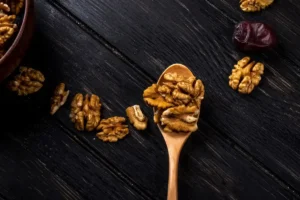
What Makes Pignole Unique Compared to Other Nuts?
It stands out for its rich, buttery flavor and soft texture, distinguishing it from other nuts. Its nutritional profile, filled with healthy fats, vitamins, and minerals, also sets it apart as a choice ingredient for both culinary and health benefits.
How Should Pignole Be Stored to Maintain Freshness?
To preserve their freshness and prevent rancidity, Pignole should be stored in airtight containers in the refrigerator or freezer. This method extends their shelf life and maintains their natural flavors.
Can Pignole Cause Allergic Reactions?
Yes, like other nuts, it can trigger allergic reactions in some individuals. Those with known nut allergies should exercise caution and consult with a healthcare provider before incorporating it into their diet.
Conclusion
Embarking on our journey through the enigmatic world of Pignole, we’ve ventured deep into a topic that, though not universally recognized, carries its unique allure and complexity. This exploration aimed not just to unveil the literal essence but to grasp the broader implications, weaving through the rich tapestry of history, uses, and cultural significance that it embodies. Throughout this article, we endeavored to unravel the mysteries of Pignole, ensuring that by the end, readers are not only well-acquainted with its core but also the nuances that elevate it to a subject of profound exploration.
Inspiration from Pignole
Our journey into Pignole’s realm sought to inform and inspire a deeper appreciation for these modest yet significant culinary jewels. We explored their distinct flavor profiles, nutritional virtues, and the meticulous cultivation and harvest processes. Their lasting legacy across various cuisines worldwide was spotlighted, emphasizing the critical role of sustainable practices in safeguarding their future.
Lessons for the Future
Closing our Pignole narrative, we embrace the sustainability lessons, the zest for culinary discovery, and an enhanced awareness of our food systems’ interconnectedness. It reminds us of nature’s gifts and the delicate balance needed for their preservation. Whether culinary experts, home cooks, or those who cherish the subtleties of consumption, Pignole’s story prompts us to reflect more profoundly on our dietary choices and their global impact.
Embracing Pignole in Culinary Adventures
By welcoming Pignole into our kitchens, whether through experimenting with new recipes, delving into its role in traditional dishes, or considering its health benefits, we join a tradition that crosses cultures and ages. This small nut, subtle yet distinct in flavor, not only elevates our meals but also enriches our comprehension of the world’s culinary heritage.
A Journey of Culinary Discovery
In conclusion, this article hopes to have provided valuable insights into Pignole, inspiring you to integrate these nutritious nuts into your culinary ventures. The path from pine cone to plate illustrates the beauty and intricacy of our food systems, reminding us of the joy and duty we share in preserving and celebrating our global culinary traditions.

